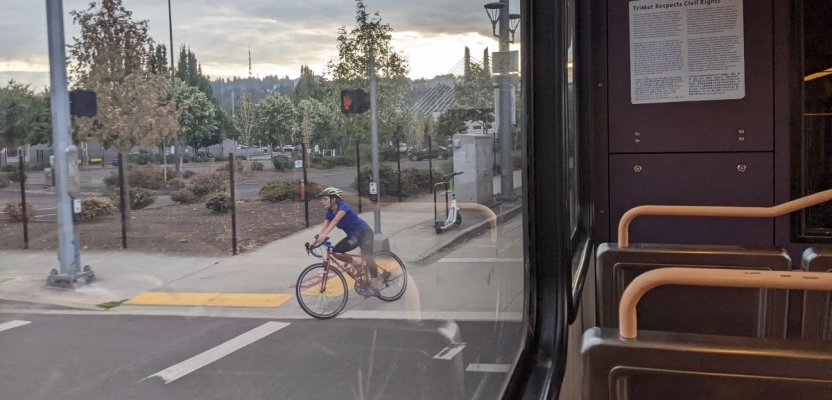Exploring How COVID-19 Has Impacted People’s Transportation Choices

Living in a car-centric society has its downsides, and many transportation professionals are working to encourage non-car travel. To do so, researchers must determine what motivates people to use other forms of transportation besides driving as well as what discourages them. The COVID-19 pandemic lowered the amount of car driving because of stay-at-home orders and the shift to remote work. Researchers from the University of Oregon saw this as the perfect opportunity to work on identifying how travel behaviors changed as a result. Other objectives of the project were to evaluate the prevalence of desire to expand travel options in the future, and to explore any new, post-COVID support for policies that encourage multimodal travel.
This project builds on the 2020 paper, “Moving Eugene Sustainably After COVID-19,” in which the researchers, Yizhao Yang and Rebecca Lewis, found that factors dissuading folks in the Eugene-Springfield region of Oregon from biking or walking pre-pandemic mattered less during the pandemic. For the NITC project, the researchers followed up with the previous interviewees as well as new participants in the Eugene-Springfield area to document how their opinions about transportation have changed since the beginning of 2020. The research refers to three distinct periods of time: Before COVID Emergency Period (before March 8, 2020, when Oregon entered a state of emergency), COVID Emergency Period (between March 8 and March 31, 2022), and Post COVID Emergency Period (began April 1, 2022 when Oregon’s COVID emergency was lifted). All of the work with survey, interview, and focus group participants was conducted in 2022; the periods help the reader to understand the chronology of the evolving opinions represented in this paper.
Before the surveys, eight participants of the 2020 survey were interviewed. Next, respondents of the 2020 survey as well as new participants were targeted for a new survey via email addresses (for repeat respondents), Facebook ads, and in-person contact. The in-person survey option was geared specifically toward the Spanish-speaking population in the area because that was a demographic that was underrepresented in the previous project. All methods of distributing this survey gave respondents the option to select that they would be open to being contacted again for a follow-up interview or focus group. Out of the 311 participants in the 2022 survey, twenty-four were selected for focus groups that took place in the Post Period.
The summary of the interviews was that there had certainly been a fluctuation in travel behaviors since the beginning of the pandemic. When the COVID Emergency Period first began, people were hunkering down, but they grew more comfortable getting outside and exploring their neighborhoods as time went on. Even so, some people were dissuaded from non-car modes of transportation. Cyclists cited aggressive driving behaviors, individuals felt least safe at night moving through neighborhoods, and the safety of buses and bus stations at night varied. The overall decrease in transit ridership and perceived health threat due to the pandemic led individuals to feel that public transport wasn’t safe. On the other hand, when walking around, people indicated that they felt safer when there were fewer people, especially in downtown Eugene.
The summary of the survey was that people’s lived experiences can be used to predict whether respondents will increase the use of a particular type of transportation in the future. For driving: people who started driving more right after the COVID Emergency Period as well as people who consider COVID threat levels to be higher will likely increase their driving in the future. For transit: people who started using transit more right after the COVID Emergency Period will likely increase their use of transit in the future; on the other hand, people who indicated greater levels of enjoyment due to less transit use during the COVID Emergency will likely not have high levels of future transit use. For walking, biking, or other modes of active transport: people who had positive experiences in their neighborhoods during the COVID Emergency Period are more likely to have greater levels of active transport in the future.
The summary of the focus groups was that there was some interest in maintaining recreational transportation behaviors in the Post COVID Emergency Period, though there are many barriers. These barriers include safety for walkers and bikers, lack of access to clean/public restrooms, lack of secure bike/equipment storage, and unreliability or inefficiency of public transit.
The overarching conclusion of the three periods’ methods was that the impact of environmental factors on travel behavior was weak compared with people’s perceptions, attitudes, and experiences. In a similar “you can lead a horse to water, but you can’t make it drink” type of way, reduced driving doesn’t by default generate levels of enjoyment that walking and biking do. Social programs and public campaigns can help show people that reduced driving can be coupled with those other modes of transportation (walking and biking) to generate the benefits that they produce.
This research was funded by the National Institute for Transportation and Communities, with additional support from the University of Oregon.
ABOUT THE PROJECT
Sustaining Multimodal Choices: Examining Travel Behavior Beyond COVID-19
Yizhao Yang, University of Oregon; Rebecca Lewis, University of Oregon
RELATED RESEARCH
To learn more about this and other NITC research, sign up for our monthly research newsletter.
- Accessing Opportunities for Household Provisioning Post-COVID-19
- Developing Strategies To Enhance Mobility And Accessibility For Community-Dwelling Older Adults
- Rethinking Streets for Physical Distancing
The National Institute for Transportation and Communities (NITC) is one of seven U.S. Department of Transportation national university transportation centers. NITC is a program of the Transportation Research and Education Center (TREC) at Portland State University. This PSU-led research partnership also includes the Oregon Institute of Technology, University of Arizona, University of Oregon, University of Texas at Arlington and University of Utah. We pursue our theme — improving mobility of people and goods to build strong communities — through research, education and technology transfer.
